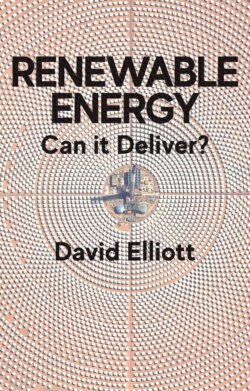Читать книгу Renewable Energy - David Elliott - Страница 27
Choices ahead
ОглавлениеIn the next chapter, I will look at how these various strategic issues have been dealt with in some of the long-term scenarios and plans that have emerged. Some analysts stress the demand side and, as noted above, that is clearly very important. For example, the Oxford Environmental Change Institute’s director, Professor Nick Eyre, has said that ‘The goals of a secure, affordable, low-carbon energy system are only achievable if energy demand is reduced, decarbonized and made more flexible’ (ECI 2018). But even in that formulation, decarbonization is presented as a key element, and that means new low- or zero-carbon supply technologies.
Nuclear power is one such option, but not one that I have covered here in much detail since, as I have argued at length elsewhere (Elliott 2010, 2017b), it has many drawbacks, including economic, safety and security issues and the problem of long-lived radioactive waste. There is also the already mentioned more practical problem that nuclear plants are inflexible and will not be much use for balancing variable renewables. They just get in the way of the more flexible supply and demand system that will be needed for a renewables based system. There have been proposals for smaller, more flexible nuclear plants, but that is some way off, their economics, as well as their safety and security risks, still being uncertain (Thomas et al. 2019).
While some still look to nuclear as an interim option, possibly using new technology, in the longer term there is the fundamental issue that nuclear fission relies on fuels that, like fossil fuels, are a fixed planetary resource. They are not being renewed and cannot be relied on indefinitely. Indeed, although estimates vary, current reserves seem likely to be sufficient to supply the global reactor fleet for only a few decades, optimistically maybe up to a hundred years or so, although less if, as some would like, the use of nuclear is expanded. New uranium finds may be made as costs rise, and new technologies, like breeder reactors and the use of thorium, can extend the use of the fissile resource, but nuclear fission is not a renewable option.
The fuel sources for nuclear fusion, if it is ever successfully developed at commercial scale, are more extensive, with one key hydrogen isotope fuel, deuterium, being available from seawater, although for the other, tritium, there may be limits to its availability on this planet. There are other uses for lithium, the main current source of tritium, including for the batteries of electric vehicles. Recourse might be made, in time, to helium-3 or other reserves off-planet, and that might be necessary if we were to try to use fusion for powering space vehicles, which otherwise will have to continue to use mainly fossil-derived fuels. However, that is all some way off, and major breakthroughs and science fiction-type futures aside, quite apart from having safety and materials irradiation issues, fusion does not seem to offer a solution to the urgent need for non-fossil fuels (Elliott 2019c).
Looking far ahead is fraught with difficulties, but the prospects for renewables do look much brighter and they are available now, unlike fusion, offering us a way to respond quickly to the climate change threat. Specific technology choices for supply and end-use management will be hard to make, but some sort of general consensus seems to have emerged in the wider picture. It does seem likely that, if we want to go that way, renewables can supply the bulk of global power by around 2050, and also heat and transport fuel, if proper attention is paid to energy saving and demand management. Nevertheless, there are differences in detail and emphasis; there is as yet no one fixed optimal energy future, but rather a series of potential routes forward, with a range of possible technologies being used. In the next chapter, I look at which options have been chosen so far and which have been or might be sidelined.
